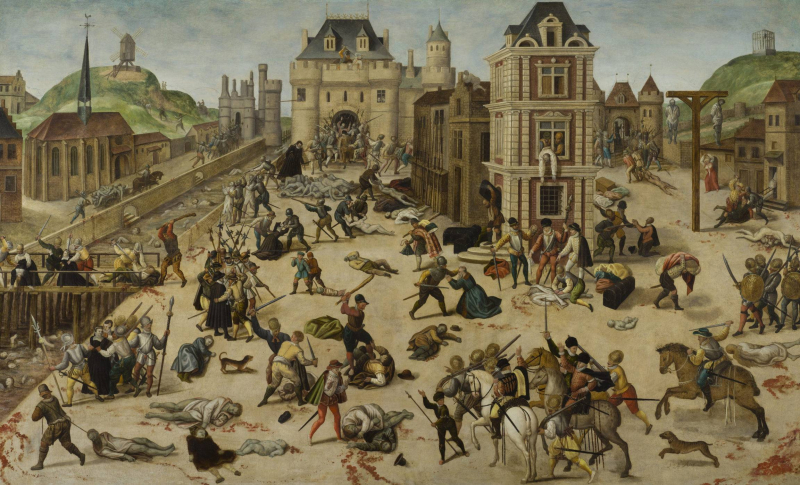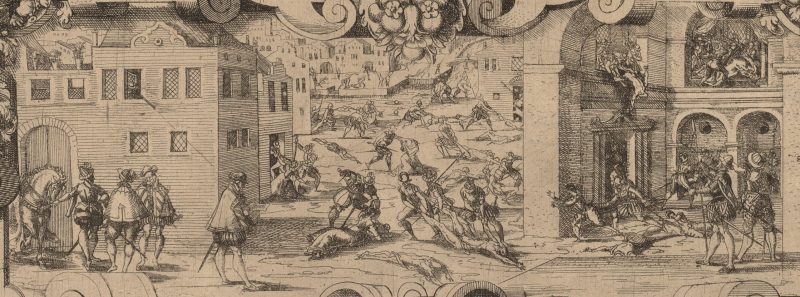 On this day in 1572, French Catholics slaughtered 30,000 Protestants in the streets of Paris. The French King and the Pope helped organize the carnage of the biggest religious massacre in Europe in the 1500s. Roughly half the Bovards living in Paris were killed in the bloodbath. Three surviving Bovards fled past drunken guards at Paris’s city gates, raced to the coast, hijacked a rowboat, and made it across the English Channel and took refuge in London. Or at least that’s the Bovard family lore I’ve read. (I know not to bet the rent money on that lore’s accuracy.)
On this day in 1572, French Catholics slaughtered 30,000 Protestants in the streets of Paris. The French King and the Pope helped organize the carnage of the biggest religious massacre in Europe in the 1500s. Roughly half the Bovards living in Paris were killed in the bloodbath. Three surviving Bovards fled past drunken guards at Paris’s city gates, raced to the coast, hijacked a rowboat, and made it across the English Channel and took refuge in London. Or at least that’s the Bovard family lore I’ve read. (I know not to bet the rent money on that lore’s accuracy.)
Some years ago at a D.C. reception, I met a cultural attache from the French embassy. She saw my name tag and asked about my last name.
“Yes, it’s French. My ancestors were Huguenots,” I said.
“Oh – they were victims,” she replied remorsefully.
“Hell no! Getting kicked out of France was the best thing that ever happened to the Bovard family,” I replied with a big grin.
She just stared at me kind of wild-eyed. I fear I may have ruined her stereotypes of Huguenots.
After fleeing France, my ancestors resettled in northern Ireland. My ancestors were reportedly linen and lace manufacturers in France but became flax growers after resettling in County Donegal. I come by rusticity honestly.
In 1846, my Bovard ancestors exited for America. Here’s the thumbnail I use to explain family history: The Bovards were kicked out of France because the king was prejudiced against Protestants and they were kicked out of Ireland because the Irish were prejudiced against horse thieves.
Actually, they left at the start of the great potato famine, but the Fact Checking Police haven’t caught up with me yet.
My kinfolk settled in western Pennsylvania. My great-great-grandfather dodged Abraham Lincoln’s military conscription, a step that I appreciate both philosophically and genetically.
Here’s an article on how the French refugees eventually got along with and intermarried with the Irish.
The 1572 carnage at least had some positive philosophical results. Philippe de Mornay barely avoided being killed in the massacre but seven years later, his pamphlet Vindiciae contra tyrannos (A Defense Of Liberty Against Tyrants) was published in Switzerland. This pamphlet laid the groundwork for subsequent authors (including British philosopher John Locke) to clearly establish the right to resist oppressive rulers. (It is available as a free download at this web page). The book contained far more solid thinking on the nature of political institutions than one will encounter in political science classes where progressive professors exalt the power of benevolent rulers, the Constitution be damned. de Mornay observed, “There is nothing which exempts the king from obedience which he owes to the law, which he ought to acknowledge as his lady and mistress.” Invoking Aristotle, he stressed, “Civilized people reduced kings to a lawful condition, by binding them to keep and observe the laws. Unruly absolute authority remained only amongst those who commanded over barbarous nations.” The vision of “government under the law” was one of the greatest lodestar of early modern political philosophy. de Mornay also derided “the minions of the court.” We have made great progress since his time – now we have think tank minions.
French philosopher Michel de Montaigne was horrified by the carnage in Paris as well as in Bordeaux, where he served periodically as mayor. Montaigne tossed out some ideas that he hoped would deter religious genocide: “It is putting a very high price on one’s conjectures to have a man roasted alive because of them.” He admitted that he could not say all that he believed: “I speak truth, not so much as I would, but as much as I dare; and I dare a little the more as I grow older.” But he never forthrightly condemned the St. Bartholomew Day’s Massacre. He gave a few winks to skepticism: “Man is certainly stark mad; he cannot make a worm, and yet he will be making gods by dozens.” He also recognized how adulation spawned some of the most dangerous illusions: “The strange luster that surrounds a king conceals and shrouds him from us.”
Almost two centuries later, Voltaire was spurred by the legal murder of a Huguenot in his time to zealously champion toleration. “Toleration has never been the cause of civil war; while, on the contrary, persecution has covered the earth with blood and carnage,” he wrote. In his Philosophical Dictionary, he declared, “What is tolerance? It is a necessary consequence of humanity. We are all fallible, let us then pardon each other’s follies. This is the first principle of natural right.”
The St. Bartholomew’s Day Massacre shows the perils of combining fanaticism with power. Unfortunately, this is a lesson which modern societies may need to learn again. A recent poll showed that more than half of Americans expect a civil war “in the next few years.” Hopefully that poll is as inaccurate as most of the polls preceding recent presidential elections. Historian Henry Adams observed a century ago that politics “has always been the systematic organization of hatreds.” Nowadays, politics seems hellbent on multiplying hatred. And few things spur hatred more effectively than tarring all political opponents as traitors. But that is increasingly the coin of the realm in political disputes. (And folks had such high hopes for the civilizing impact of Twitter…..)
Toleration requires fewer body bags than rage.
Here are some outtakes from French publications on the anniversary:
Dans la nuit du 24 août 1572, 30 000 protestants sont massacrés par les ligueurs catholiques dans les rues de la capitale
On the night of August 24, 1572, 30,000 Protestants were massacred by the Catholic League in the streets of the capital.
Catherine de Médicis regarde les cadavres de protestants au lendemain du massacre de la Saint-Barthélémy.
Catherine de’ Medici looks at the corpses of Protestants the day after the St. Bartholomew’s Day massacre.
C’est un mercenaire, Jan Yanowitz, qui tue, dans son lit, Coligny. Le cadavre est défenestré, émasculé, jeté à la Seine puis repêché pour être pendu par les pieds au gibet de Montfaucon.
A mercenary, Jan Yanowitz, kills [Admiral] Coligny in his bed. The corpse is castrated, thrown out a window into the Seine, and then fished out to be hung upside down on the Montfaucon gallows.
Ce massacre de plus de 200 nobles est suivi, toute la nuit et le jour suivant, par une recherche en règle de tout ce qui est protestant pour être égorgé, éventré, femmes et enfants compris.
A massacre of more than 200 [Huguenot] nobles is then followed by a search for Protestants to be slaughtered and disemboweled, women and children included.
https://www.nationalgeographic.fr/histoire/saint-barthelemy-les-veritables-causes-du-massacre




Thank you!
Jean, do you know when your ancestors exited France? Many (most?) Protestants did not flee until the 1680s, when Louis XIV treacherously revoked the Edict of Nantes (which had promised perpetual toleration).
It seems as if the Catholic church has found ways to instigate or participate in massacres in every century since its creation. I don’t think much of Protestant denominations either, but the Catholic church leads the way in its blatant corruption of Jesus’ teachings. As I understand it, Jesus never meant to found a new religion, only to clean up Judaism. Not that there’s anything wrong with starting over, but it’s a shame Christianity want so wrong so quickly. Laurence Vance does a great job documenting the mess churches have made for themselves today, worshiping the U.S. military above the Prince of Peace.
I’m very glad your ancestors made it out of France alive, or else whose columns would I read in 2022?
Thanks for the positive spin on my ancestors. At least one of ’em got away long enough to scatter seeds.
Voltaire and Montaigne both had apt observations on religious fervor gone to the dark side.
Always a font of wisdom and historic insight – thank you Jim. I wonder when Americans will start treating their political opposition thusly…
Thanks for your kind words, Lorraine – always happy to hear from my fav Gitmo defense lawyer. Hopefully Americans wise up and realize that perpetual political poison can’t be reconciled with domestic tranquility.